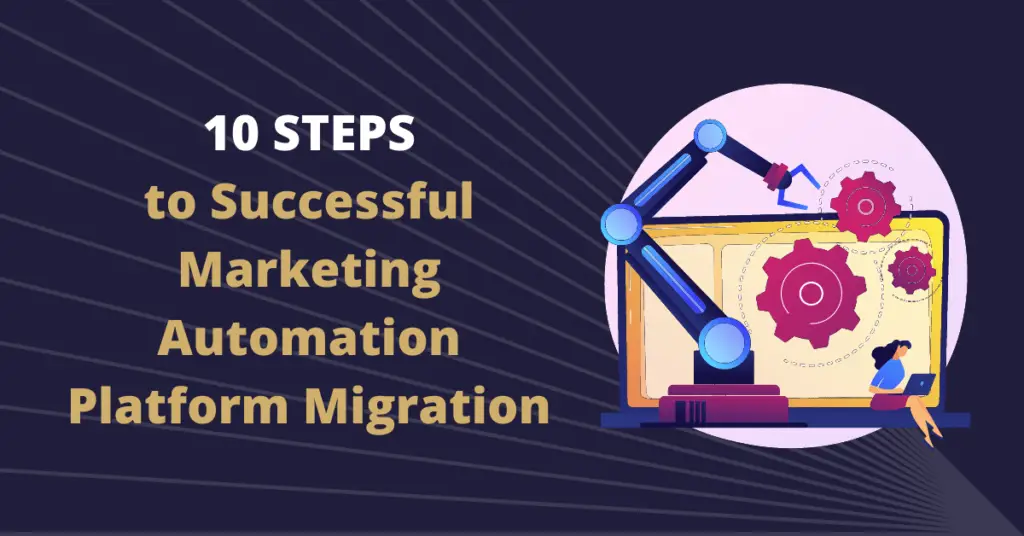
Migrating to Oracle Eloqua can be the turning point where your marketing automation goes from “good enough” to a true growth engine. But without the right process, the transition can turn into a costly, time-consuming headache—resulting in lost data, broken campaigns, and frustrated teams. This Eloqua migration checklist walks you through a proven 10-step process we’ve used to help marketing teams switch platforms with zero downtime and full data integrity.
Whether you’re moving from HubSpot, Marketo, Pardot, or another platform, success comes down to following a clear, structured plan that protects your data and keeps your marketing running smoothly. Follow these steps, and you’ll be ready to launch Eloqua quickly, confidently, and without the costly missteps.
Eloqua Migration Checklist: 10 Steps to Avoid Costly Mistakes
Simply put, marketing migration involves transferring all your information from one platform to another, likely with the help of an integration tool or service. But platform migration requires more attention and care than a simple file transfer between systems. Aside from data security, you also need to choose what to migrate in the first place and double-check that the new system is compatible with your usual marketing procedures. Feeling a little lost? To simplify the process, this Eloqua migration checklist will help you stay on track from start to finish.
1. Look at the Big Picture Before Your Eloqua Migration
Start by developing a plan for the whole process. Make a list of every data component to migrate and set a deadline for each one. Even seemingly insignificant pieces of data need to move. More importantly, every piece of data needs attention to ensure it’s transferred correctly. This is the foundation of any Eloqua migration checklist.
2. Plan and Prioritize Your Eloqua Data Migration Steps
During the migration process, there will be many moving parts to track and deadlines to meet. Following a prioritized Eloqua migration checklist ensures you know exactly what data needs to move first and what can wait until later. Handling the essentials first gives you more time to transfer the rest.
3. Manage, Clean, and Back Up Data Before Migration to Eloqua
An effective Eloqua migration checklist always includes a thorough data audit. Dirty data like hard bounce backs will only add more time to the migration process and take up valuable space in the new platform. Remove all unusable entries, verify consent information, and create a backup before moving anything. If something goes wrong, you’ll be glad you did.
4. Align Naming Conventions for Eloqua Compatibility
As you prepare for migration, ensure the target platform supports your existing naming conventions. Standardize and, if needed, shorten values to fit Eloqua’s capabilities. This step should be clearly outlined in your Eloqua migration checklist to avoid rework.
5. Decide Which Eloqua Activity Data to Migrate and Archive
Not all activity data is worth migrating. Your Eloqua migration checklist should help you decide which records are critical to keep and which can be archived. For example, ten-year-old engagement logs may not be relevant unless tied to legal or compliance matters.
Need Expert Help With Your Eloqua Migration?
Our certified Eloqua specialists can review your data, clean your lists, and design a migration plan that saves weeks of work.
Book Your Free Migration Audit →
6. Test Data Functionality After Eloqua Migration
After transferring your data, use your Eloqua migration checklist to verify every key process—lead management, segmentation rules, reporting, and automation triggers—before going live.
7. Test Third-Party Integrations with Eloqua
If you rely on third-party integrations, test them early. Your Eloqua migration checklist should include running dummy data through these apps to check compatibility and ensure nothing breaks when you switch systems.
8. Set Up Redirects to Preserve Landing Page Performance
Migration affects your customers too. As you transfer to a new platform, you’ll need to make sure your customers can still access your website from links they may have already saved. Draw up a list of affected landing pages for your technical team to focus on. Following the migration process, your customers can be redirected to your new web pages instead of facing a 404-error message.
9. Train Your Team for a Smooth Eloqua Implementation
This one is straightforward—bring your marketing team up to speed. Provide training sessions or materials they can review and make sure they can find answers to their questions.
10. Follow Up and Monitor Eloqua Migration Performance
Your migration process may be finished, but you still have some work to do. Migration to a new system like Eloqua may change certain values including domain names and IP Addresses that can affect deliverability. Be certain to follow best practices for new system start-ups.
Conclusion
Marketing automation platform migration doesn’t happen often. With any luck, your new platform will last you for many years. But when migration is necessary, poor planning will cost you time and money that you can’t afford. Stick to reliable tools and best practices for migration and use our 10-step process to minimize the risk of errors.
Need help migrating from your old marketing automation platform to Eloqua? We can help! Don’t risk lost leads or broken campaigns. Book your free Eloqua migration audit today and see exactly how we can move you faster, safer, and smarter. Contact us today for more information on our Eloqua integration services.





